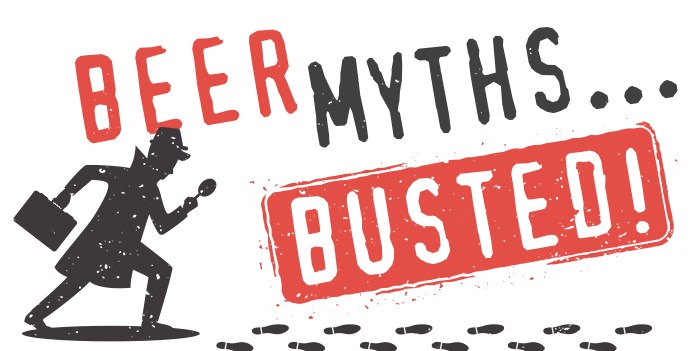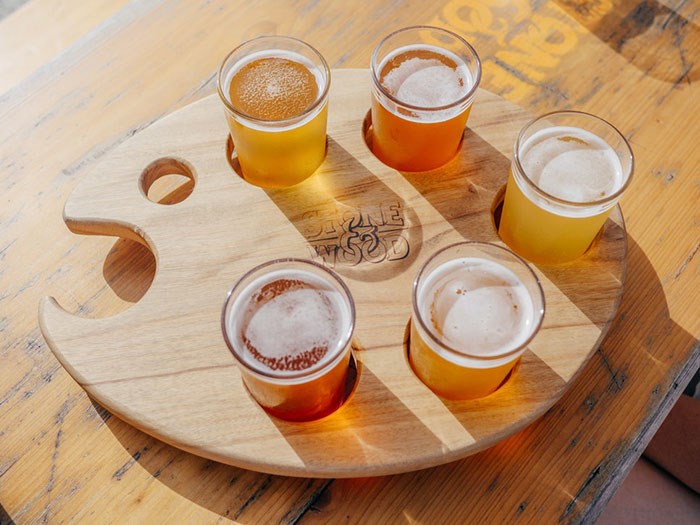
Here at Growler HQ, we get a lot of questions from readers asking us debunk common misconceptions about beer. We thought we’d address some of the most persistent myths with some help from the top beer minds in B.C.
Draft beer is always better: BUSTED
Draft beer is better—only sometimes. While it’s true that if you’re drinking a beer style that lends itself to being consumed fresh (like a pilsner or a West Coast pale ale), and you’re drinking it at an establishment that regularly flushes it’s lines and keeps its taps clean, then draft is preferable—especially if you’re getting it fresh off the bright tanks at the brewery itself.
But some beers benefit from cellaring, and an extended stay in a bottle can help smooth out the body and temper harsh tannins.
“I’ve had a few beers that need to sit and mellow out, and you just can't do that with draft,” says R&B Brewing’s Lundy Dale.
When it comes to draft beer, Dale says the best option is always to get it from the source at the brewery tasting room, as the beer will be freshest and it will be served the way the brewery wants it to be.
“A secondary source that maintains its lines and understands the beer, like the Alibi Room, is a great place for draft beer,” says Dale. “But [the quality of draft beer] mostly depends on where you get the beer.”
 Photo: Unsplash / Tim Bennett
Photo: Unsplash / Tim Bennett
Beer should always be served as cold as possible: BUSTED
“Coldness is enshrined as one of the most important qualities of beer and the race to the bottom of the thermometer has spawned ice towers and frosty mugs and all kinds of frozen hellish gimmicks,” says Adam Chatburn, of the now sadly defunct Real Cask Ales. “The reason why draft beer is actually served cold is that variations in the dispensing temperature can lead to foaming and therefore beer waste. Foaming will also occur when beer is poured into a frosty mug pulled from a freezer as the ice creates nucleation points.”
But how does it affect the flavour of beer? Unfortunately, beer served close to freezing will numb your tongue and prevent you from tasting much of anything, which might be beneficial if you’re pounding back pints of macro swill.
“If we let the beer warm slightly we will start to pick up flavours quickly,” says Chatburn. “This is very noticeable in darker beers like stouts and porters where subtler flavours like tobacco and chocolate could be missed served ice cold.”
It’s fine to store beer at room temperature: BUSTED
“Beer changes as it ages and the warmer it's stored, the faster those changes happen,” says Dageraad’s Ben Coli. “Some of the changes will never happen at cold temperatures, others will happen very slowly.”
Any beer intended to be consumed fresh should be kept refrigerated to maintain freshness. How fast that freshness fades will depend on how well the beer was packaged and how much the beer's flavour depends on hops.
Many higher alcohol beers, however, like barleywines, imperial stouts and big Belgian quadrupels, taste better with age.
“Complex processes slowly happen in the beer, with acids combining with various alcohols to form new esters, which can taste rich and fruity,” says Coli. “These processes will happen way faster out of a fridge than in one.”
Temperature stability is important: aging beer is better done at cellar temperature (15 C) as opposed to room temperature (22 C).
 Beer/Shutterstock
Beer/Shutterstock
Import beer is, well, imported: BUSTED
You might assume that the “import” beer you’re drinking is, in fact, imported from its country of origin, but sometimes that’s not the case. A number of international brands are actually brewed under licence for the Canadian market right here in Canada. Budweiser might be America’s King of Beers, but it’s actually brewed in Creston, B.C., at Labatt’s Columbia Brewery, home of Kokanee. American brands like Coors Light, Pabst Blue Ribbon and Old Milwaukee are also brewed north of the border. Japanese lager Sapporo is brewed at the Sleeman Brewery in Guelph, which is owned by Sapporo. Heineken and Beck’s were both at one point brewed here in Canada, but are currently imported from Europe.
If you’re curious about where your beer is brewed, all you have to do is look at the label: under B.C. law, labels are required to state where the beer was brewed.
Bottles are better than cans: BUSTED
Cans offer a ton of advantages for breweries: namely, they’re cheaper than bottles to produce, they’re not as fragile and they’re lighter and therefore cheaper to ship. Cans are also more environmentally friendly (often containing close to 70% recycled aluminum).
But how do cans affect the taste of the beer?
Scientific testing has found that consumers perceive beer that’s been poured out of a bottle to taste better than canned beer, but in a blind tasting, they couldn’t tell the difference. In fact, cans are better at preserving beer by keeping oxygen and light out, you are less likely to experience off flavours with canned beer.
So what’s the downside? Glad you asked. Aluminum beer cans have an epoxy lining that contains BPA, a thyroid-disrupting chemical that has been linked to numerous health issues when consumed in high concentrations. While a very, very small amount of BPA does leach into canned beer, your exposure is roughly equal to breathing in household dust. Lets be honest, you should be way more concerned about what the alcohol is doing to your body.
As a result, canned beer shouldn’t be cellared for years on end—which is why most beer that’s suitable for aging is bottled.
 To learn more, visit TheGrowler.ca
To learn more, visit TheGrowler.ca


